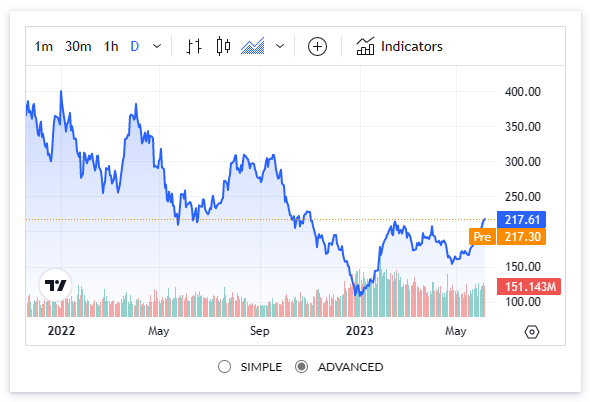Why Stock and Bond Prices Move
Stock and bond prices move up and down every day, sometimes by very large amounts. Before you start investing, the first thing to understand is why these price movements happen, and how to plan for them.
Stock Price Movements
Stock prices are often represented on a line graph that shows the change in price over time. While some stocks may show significant movements, others may display smaller shifts. The movement of these stocks reflects the present value of future earnings expectations and is divided by the total number of shares issued by the company. In turn, stock prices reflect the expected performance of a company in the future. These movements are influenced by a variety of factors such as the company’s financial performance, market trends, economic conditions, and investor sentiment.

When a company performs well financially or when investor sentiment is favorable, its stock prices may rise. Alternatively, negative economic factors or unfavorable market conditions can lead to a decrease in stock prices. Overall, stock prices move based on the complex interactions of numerous external and internal factors influencing the financial markets.
To understand how the process works, let’s start at the beginning, and review how an investment bank oversees a company’s initial public offering (IPO).
Investment Banks
Investment banks, such as Goldman Sachs Group Inc. (GS), JP Morgan Chase & Co. (JPM), or UBS Group AG Registered (UBS), play a vital role in the initial public offering (IPO) process. These banks work closely with companies looking to go public and act as their underwriters. They provide assistance in pricing the offering by analyzing market demand and company performance, and determining the best time to launch the IPO. The investment banks also help the company meet the necessary legal and regulatory requirements, create a prospectus, and market the offering to potential investors.
The IPO Process

The process begins with a company discussing the pitch for an IPO with bankers. The company selects book runners and co-managers who will be responsible in selling the newly issued stocks for the primary bank. The company must file the registration forms and discuss the timing of the IPO. The bankers then conduct due diligence, a process where they speak to customers, do research and analysis on the industry and trends, figure out the legal situation, and sift through the financial statements and make sure there are no irregularities. The S-1 form is filed after the due diligence, which releases the historical financial statements, key data, and other information investors would like to see before making a purchase decision.
The pre-marketing stage involves bankers speaking to investors regarding the company and industry in order to determine a price range to sell the initial stock offering. The final price will be set after more conversations with investors. Banks will then allocate shares to different investors prior to the first day of trading. Once shares are allocated, investors can now buy, sell, and trade with each other while the general public can begin to purchase shares.
The period following the IPO is often considered the most volatile period in a stock’s history because of investor sentiment. Investor sentiment is how large-scale buyers of stocks feel about companies, industries, and the market as a whole. Investors are typically large financial institutions that employ economists, analysts, and industry experts who drive the appetite of a specific stock or industry.
Investors that are bearish are under the assumption there will be a decline in the stock or market. Bullish investors anticipate growth in a specific stock or the market. Investor sentiment is driven in part due to earnings.
Expected vs Realized Earnings
The realized and expected earnings of a company have a significant impact on the movement of its stock price. Realized earnings refer to a company’s actual earnings for a given period, while expected earnings are what investors predict the company will earn in the future. When a company’s realized earnings exceed expectations, it is often a positive sign for investors and leads to an increase in the stock price.
On the other hand, when realized earnings fall below expectations, stock prices tend to decrease as investors believe the company’s future prospects may be challenging. Overall, realized and expected earnings play a critical role in determining investors’ perception of a company’s financial performance and can significantly influence the movement of its stock price.
Earnings reports are made available to the public to announce a company’s most recent historical performance. Quarterly reports feature the previous three months, while annual reports provide a snapshot of the most recent year. These reports feature commentary from the company about initiatives and projections moving forward.
The EPS, or earnings per share, is one of the most crucial metrics that can impact stock price movements in the short and long run. During quarterly earnings announcements, analysts create a consensus estimate for a company’s EPS, representing the sum of its net profit divided by the total number of outstanding shares. A company’s actual EPS is then compared to the estimate. If the actual EPS is higher than the estimate, stock prices are likely to rise as investors become more optimistic about the company’s future prospects. In contrast, if the company’s actual EPS falls short of the estimate, stock prices typically fall.
Investors use other metrics and ratios within the earnings report, such as revenue, margins, and P/E ratios, that can further influence stock price movements. Overall, understanding how EPS and other financial metrics can influence stock price movements is essential for investors looking to make sound decisions in the stock market.
Systematic vs Unsystematic Risk

Finally, stock price fluctuations deal with the concept of risk. There are two types of risk, systematic and unsystematic. Systematic risk is an event that can affect the stock market as a whole. Unsystematic risk is specific to the company or industry. Beta is the measure of the volatility a stock has in comparison to the market as a whole. A beta greater than 1 represents a stock that will move higher than the market in periods of growth but decrease more in periods of decline.
Systematic Risk
Systematic risk includes events such as wars, interest rate fluctuations, recession, and geopolitical occurrences. These events tend to affect all stocks regardless of company specific performance and growth prospects. Systematic events are seen as disruptions to the market and generally cause a downward shift in stock prices.
Unsystematic Risk
Unsystematic risk includes company or industry specific events. For example, companies that produced radios were at risk when TVs became popular, or companies that grow and sell vegetables are affected by droughts or hurricanes that destroy their crops. These risks can greatly affect a stock, and often cause sharp declines in price.
Bond Price Movements
Companies can raise money through stocks or equity, however, another option is raising debt. One popular way to do this is through bonds, which are issued by large corporations such as Apple and Amazon, as well as cities such as New York and Los Angeles, states like Illinois and Florida, and countries such as America and Brazil. Investors buy these bonds and receive payments of a fixed interest rate, known as the coupon, along with the principal, over time. When bonds are issued, they are assigned a par rate, which is the initial price of the bond.
How Bonds Work

Let’s say Apple needed $100 million to fund a new factory and decided to issue bonds with a maturity date of 10 years. Then, Apple would determine an interest rate that investors would be willing to lend their money for. If the interest rate was set at 5%, Apple would need to pay investors 5% of the borrowed amount each year until the maturity date of the bond, which is the year the money will be returned. Bonds are usually issued in denominations of $1,000.
Therefore, if you were to purchase a $1,000 bond from Apple, you would loan them the money upfront and receive 5% of $1,000, or $50, every year for the next 10 years. At maturity, Apple would return the $1,000 to you.
Interest Rates and Bonds
Bond prices, much like stock prices, experience fluctuations. The first and major implication is interest rate risk. Suppose you invest in a corporate bond that pays a fixed interest of 5% until maturity, while the central bank interest rate is 2%. If the central bank rates rise while you own the bond to 4%, the price of your bond will fall.
This is because investors are always comparing the risk and return of bonds with anything else they could be investing in. If your bond pays 5% compared to the central rate of 2%, you are earning a 3% premium. If your premium drops to 1%, there would be few investors interested in buying your bond. Interest rates have an inverse relationship with bonds; as rates rise, bond prices fall, and vice versa.
Inflation and Bonds
A second factor in bond price fluctuation is inflation. Inflation is when the value of currency decreases over time. If a bond is paying a coupon of 5% on a $1,000 bond, the value of the coupon is worth less in the 10th year then in the current one. As a result, the effective yield is lower as the market price of the bond decreases. As a result, we have a second inverse relationship, as inflation increases bond prices decrease, and vice versa.
Credit Ratings
Another factor that can influence bond prices is the credit rating assigned by credit rating agencies like S&P Global Ratings, Moody’s, and Fitch. These agencies conduct investment analysis on companies and assign independent debt ratings that range from AAA (very low probability of default) to D (complete default of debt). When a company’s debt rating goes up, the price of their bonds usually increases as well, and new bonds may have lower interest rates. Conversely, when the rating drops, bond prices tend to fall, and new bonds may have higher interest rates. Essentially, a company’s credit rating can significantly influence the interest rate for their bonds and how likely investors are to invest in them.